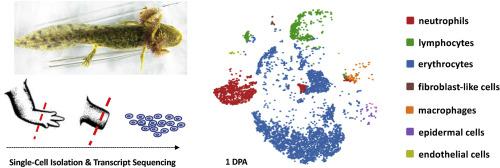Experimental Cell Research ( IF 3.3 ) Pub Date : 2020-06-18 , DOI: 10.1016/j.yexcr.2020.112149 A K Rodgers 1 , J J Smith 2 , S R Voss 1

|
Immune cells are known to be critical for successful limb regeneration in the axolotl (Ambystoma mexicanum), but many details regarding their identity, behavior, and function are yet to be resolved. We isolated peripheral leukocytes from the blood of adult axolotls and then created two samples for single-cell sequencing: 1) peripheral leukocytes (N = 7889) and 2) peripheral leukocytes with presumptive macrophages from the intraperitoneal cavity (N = 4998). Using k-means clustering, we identified 6 cell populations from each sample that presented gene expression patterns indicative of erythrocyte, thrombocyte, neutrophil, B-cell, T-cell, and myeloid cell populations. A seventh, presumptive macrophage cell population was identified uniquely from sample 2. We then isolated cells from amputated axolotl limbs at 1 and 6 days post-amputation (DPA) and performed single cell sequencing (N = 8272 and 9906 cells respectively) to identify immune and non-immune cell populations. Using k-means clustering, we identified 8 cell populations overall, with the majority of cells expressing erythrocyte-specific genes. Even though erythrocytes predominated, we used an unbiased approach to identify infiltrating neutrophil, macrophage, and lymphocyte populations at both time points. Additionally, populations expressing genes for epidermal cells, fibroblast-like cells, and endothelial cells were also identified. Consistent with results from previous experimental studies, neutrophils were more abundant at 1 DPA than 6 DPA, while macrophages and non-immune cells exhibited inverse abundance patterns. Of note, we identified a small population of fibroblast-like cells at 1 DPA that was represented by considerably more cells at 6 DPA. We hypothesize that these are early progenitor cells that give rise to the blastema. The enriched gene sets from our work will aid future single-cell investigations of immune cell diversity and function during axolotl limb regeneration.
中文翻译:

通过单细胞测序鉴定再生蝾螈肢体中的免疫和非免疫细胞。
众所周知,免疫细胞对于蝾螈(墨西哥蝾螈)肢体的成功再生至关重要。),但有关其身份、行为和功能的许多细节尚未解决。我们从成年蝾螈的血液中分离出外周白细胞,然后创建了两个用于单细胞测序的样本:1) 外周白细胞 (N = 7889) 和 2) 来自腹腔内的推定巨噬细胞的外周白细胞 (N = 4998)。使用 k 均值聚类,我们从每个样本中鉴定了 6 个细胞群,这些细胞群呈现出指示红细胞、血小板、中性粒细胞、B 细胞、T 细胞和骨髓细胞群的基因表达模式。从样本 2 中唯一确定了第七个推定的巨噬细胞群。然后,我们在截肢后 1 天和 6 天(DPA)从截肢的蝾螈肢体中分离细胞,并进行单细胞测序(分别为 N = 8272 和 9906 个细胞)以鉴定免疫和非免疫细胞群。使用 k 均值聚类,我们总共确定了 8 个细胞群,其中大多数细胞表达红细胞特异性基因。尽管红细胞占主导地位,但我们使用了一种无偏见的方法来识别两个时间点的浸润中性粒细胞、巨噬细胞和淋巴细胞群。此外,还鉴定了表达表皮细胞、成纤维细胞样细胞和内皮细胞基因的群体。与先前实验研究的结果一致,中性粒细胞在 1 DPA 时比 6 DPA 时更丰富,而巨噬细胞和非免疫细胞则表现出相反的丰度模式。值得注意的是,我们在 1 DPA 时鉴定了一小群成纤维细胞样细胞,在 6 DPA 时由相当多的细胞代表。我们假设这些是产生胚泡的早期祖细胞。我们工作中丰富的基因集将有助于未来对蝾螈肢体再生过程中免疫细胞多样性和功能的单细胞研究。











































 京公网安备 11010802027423号
京公网安备 11010802027423号